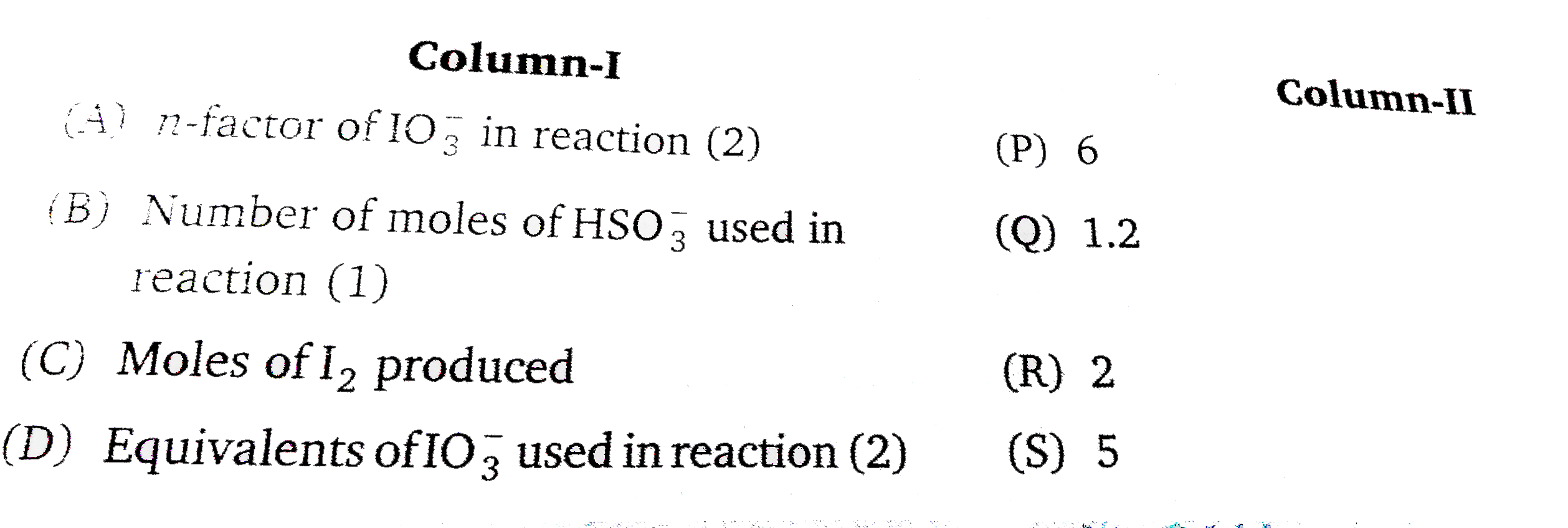Chile salt peter a source of NaNO3 also contains NaIO3 the NaIO3 is a source of I2 produced as shown in the following equation:
Step I: IOɵ3+3HSOɵ3+3SO2−4
Step II: 5Iɵ+IOɵ3+6H⊕→3I2(s)+3H2O
One litre sample of chile salt peter solution containing 6.6 g NaIO3 is treated with NaHSO3 Now an additional amount of same solution is added to the reaction mixture to bring about the second titration. Calculate the weight of NaHSO3 requried in step I and what additional volume of chile salt peter mist be added in step II to bring out complete conversion of Iɵ to I2.
[MwofNaIO3=198,MwofNaHSO3=104]
(a). 6e−+IOɵ3→Iɵ(n=6)
(b). 10e−+2IOɵ3→I2(n=102=5)
(c). HSOɵ3→SO2−4+2e−(n=2)
(d). 2Iɵ→I2+2e−(n=22=1)
m Eq of NaHSO3=m Eq of NaIO3
=N×V=6.6×1031986=200
m Eq of NaHSO3=200
W×1031042=200
WNaHSO3=10.4g
Also m" Eq of "Iɵ formed in step I using n-factor of 6=200
6e−+IOɵ3→Iɵ
In step II, the valence factor or n-factor of IOɵ3 IS 5.
IOe−+2IOɵ3→I2(n=102=5)
Thus m" Eq of "Iɵ formed using n-factor of 1=2006
m" Eq of "NaIO3 used in step II=2006
N×V=2006
6.61985×VmL=2006
VNaIO3=200×1986×5×6.6=200mL
Topper's Solved these Questions
- STOICHIOMETRYBOOK - CENGAGE CHEMISTRYCHAPTER - STOICHIOMETRYEXERCISE - Exercises Linked Comprehension
42 Videos
- STOICHIOMETRYBOOK - CENGAGE CHEMISTRYCHAPTER - STOICHIOMETRYEXERCISE - Exercises Multiple Correct
30 Videos
- STOICHIOMETRYBOOK - CENGAGE CHEMISTRYCHAPTER - STOICHIOMETRYEXERCISE - Ex 3.7
5 Videos
- STATES OF MATTERBOOK - CENGAGE CHEMISTRYCHAPTER - STATES OF MATTEREXERCISE - Exercises (Ture False)
25 Videos
- THERMODYNAMICSBOOK - CENGAGE CHEMISTRYCHAPTER - THERMODYNAMICSEXERCISE - Archives (Subjective)
23 Videos
Similar Questions
Chile saltpetre, a source of NaNO3 also contains NalO3. The NalO3 can be used as a source of iodine, produced in the follwng reactions:
IO−3+3HSO−3→I−+3H++3SO2−4 ....(1)
5I−+IO−3+6H+→3I2(s)+3H2O ....(2)
One litre of chile salphere soltuion containg 5.08gNaIO3 is treated with stochiometric quanity of NaHSO3. Now an additional amount of same solution is added to reactiion mixture to bring about the secound reaction. How many grams of NaHSO3 are required in step i and what additional volume of chile salphetre must be added in step II to bring in complete conversion of I− to I2?
View SolutionChile salt peter a soure of NaNO3 also contains NalO3. The NalO3 can be used as a surece of iodine produced in the following reactions :
Step 1 : lO−3+3HSO−3→l−+3H++3SO2−4
Step 2 : 5l−+lO−3+6H+→3l2+3H2O
One litre of chile salt peter solution containing amount of same solution is added to the reaction mixture to bring about the second reaction . How many grams of NaHSO3 are required in step 1 and what additional volume of chile peter must be added in step 2 to bring in complete conversion of l− to l2 ?
View Solution
Knowledge Check
In the following reaction:
Cr(OH)3+OH−+IO−3→CrO2−4+H2O+I−AIO−3 is oxidising agentBCr(OH)3 is oxidisedC6e− are being taken per iodine atomDnone of theseWhich of the following are isoelectronic?
NOɵ3,CO2−3,ClOɵ3,SO2ANOɵ3,CO2−3,ClOɵ3BNOɵ3,CO2−3,SO2CCO2−3,ClOɵ3,SO2DNone of theseThe coefficients of I−,IO−3 and H+ in the balanced redox reaction,I−+IO−3+H+→I2+H2O−, are respectively
A5,1,6B1,5,6C6,1,5D5,6,1
A sample of raw material contain NaNO3. It contains some NaIO3 also. The NaIO3 can be used as a source of iodine, produced in the following reactions:
IO−3+HSO−3→I−+SO−4...................(1)
I−+IO−3→I2+H2O............(2)
One litre of sample solution containing 396 g NaIO3 is treated with stoichiometric quantity of NaHSO3. Now a substantial amount of solution is added to reaction mixture to bring about the reaction (2).

View SolutionA sample of raw material contain NaNO3. It contains some NaIO3 also. The NaIO3 can be used as a source of iodine, produced in the following reactions:
IO−3+HSO−3→I−+SO−4...................(1)
I−+IO−3→I2+H2O............(2)
One litre of sample solution containing 396 g NaIO3 is treated with stoichiometric quantity of NaHSO3. Now a substantial amount of solution is added to reaction mixture to bring about the reaction (2).

View SolutionWhich of the following are isoelectronic?
NOɵ3,CO2−3.ClOɵ3,SO2
View SolutionComplete the following equations :
(i) HNO3+P4O10→
(ii) IO3+I−+H+→
View SolutionBalance the following equation by oxidation number method
NaIO3+NaHSO3→Na2SO4+NaHSO4+I2+H2O
View Solution
